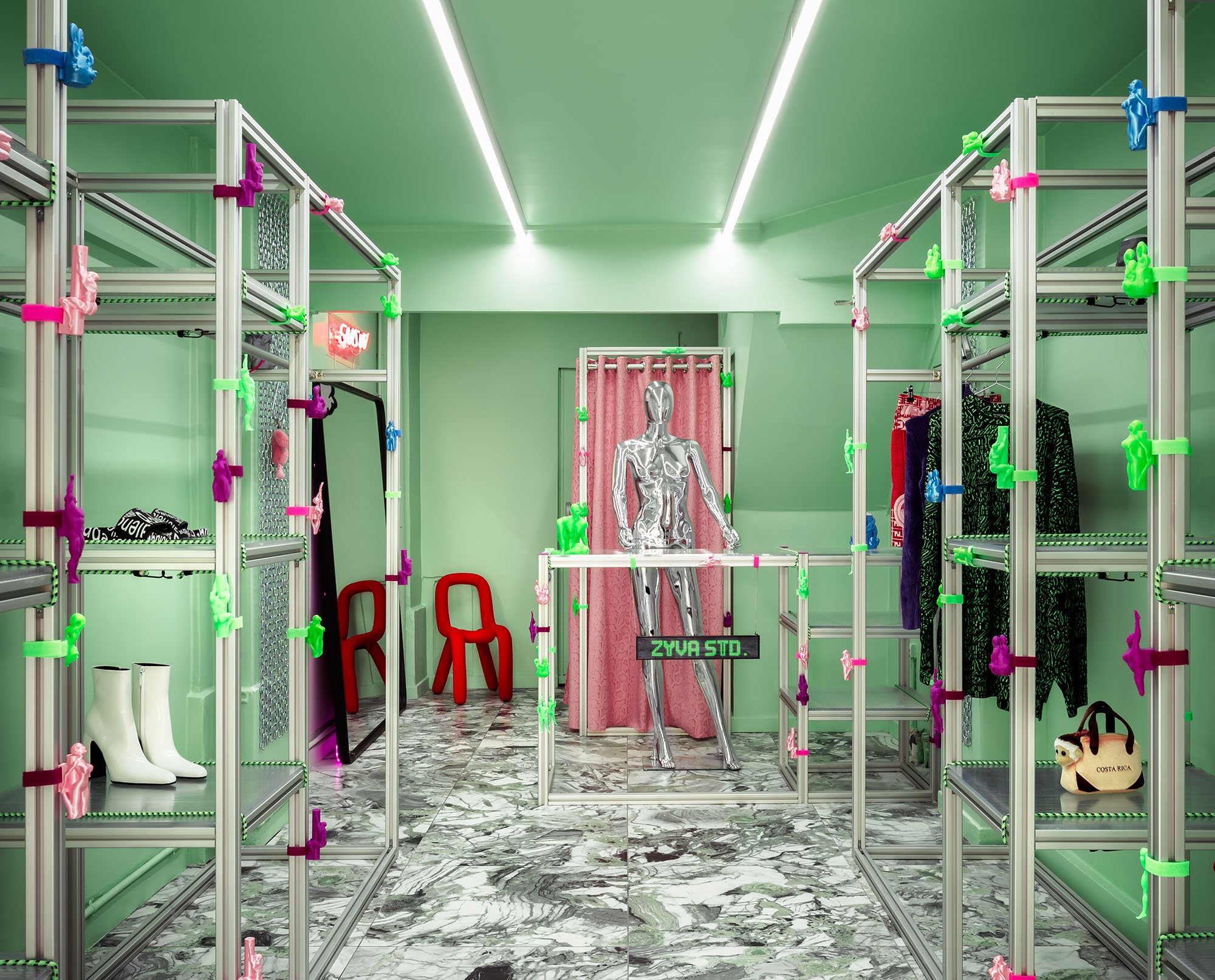Zyva Studio’s Founder Reveals The Metaverse and Trans-Design
Influenced heavily by fiction and subcultures (from reality television and Japanese manga to extreme fitness and plastic surgery), many of Zyva Studio’s digital interiors appear to be designed for machines rather than humans.

Zyva Studio’s Founder Reveals The Metaverse and Trans-Design
Also Read: Buro Happold’s SE 2050 commitment calls for zero embodied carbon in all future projects.
Anthony Authié, the company’s founder, coined the term “trans-design” in 2019 to refer to a hybrid architecture characterised by the composite aesthetics of mythological and transhuman creatures. Since then, the Paris-based architect and designer have been an active participant in the worlds of virtual architecture, dreamscapes, and non-linear time, while also beginning to explore his concepts in three dimensions using physical spaces and digitally fabricated objects.
How is your work evolving in terms of the objects and spaces you design in light of the metaverse’s rise?
For the last few years, I’ve had the impression that architecture is splintering—in a good way. There is no longer a predefined style. Instead, everything is mixed and blended—Modernist, Brutalist, Rococo, Futurist, organic, grunge, cyberpunk, minimalist, maximalist, small-scale, large-scale. This movement provides a platform for everyone who wishes to express themselves, and this movement is highlighting the metaverse’s emergence.
Also Read: Architects Paritzki and Liani built a triangular white stone house.

Zyva Studio’s Founder Reveals The Metaverse and Trans-Design
A virtual space in which anything is possible will inevitably result in a series of innovations in how we live in, represent, and inhabit cities. However, similar to Mori Masahiro’s Uncanny Valley theory, it will be necessary to cross this “zone grise” in which progress toward human imitation initially results in increased rejection but increases acceptance beyond a certain level of realism.
Could you elaborate on the term “trans-design” and the relationship between the body and architecture?
Throughout my studies, I was heavily influenced by the composite aesthetics of mythological and transhumanist creatures like the minotaur or cyborg. In my design and architectural practice, I constantly attempt to doubt the inescapable relationship between the body and its environment. In my 2019 essay “Muscle,” I examined the parallels between bodybuilders and architecture for the first time.

Zyva Studio’s Founder Reveals The Metaverse and Trans-Design
To erect something is to build. Bodybuilding is primarily concerned with muscle development and overall body strength. By engaging in alterophilia, these athletes create a new body for themselves, similar to armour, which serves as a shelter. In other words, it is a membrane that encases the human body. And, like architecture, it serves as a link between the body and its surroundings.
Also Read: Homes With Lush Indoor Trees That Add To The Peace
In my work, we frequently come across these bodies. Occasionally, in the most literal sense, they become an integral part of the furniture, taking the place of the base or seat. Although the concept of the body in architecture is not new (consider Caryatids as pilasters on Ionic buildings).
What interests me in virtual space is that these bodies can contort indefinitely, be endowed with supernatural strength, be composed of various robotic or mechanical elements—the skin can become soft like cotton or break like glass. Thus, depending on its application, the body in virtual space can alter our perception of it.

Zyva Studio’s Founder Reveals The Metaverse and Trans-Design
What has been your experience with NFTs?
We collaborated with Charlotte Taylor on Architoys to enable people to collect unique architectural concepts. The concept, which was materialised in a capsule the size of AirPods, was to create a small object that could be exchanged similarly to Pokémon cards. However, we also want to create a physical container to store all of the documents associated with a project (plans, 3D files, descriptions of the work, etc.).
This enables collectors to construct their architectural projects in reality or even integrate them into land purchased in a metaverse. Apart from their primary functions, the Architoys aim to safeguard architects’ and 3D artists’ virtual projects by immobilising them in a particular era and market. The capsules act as “time capsules,” preserving the architectural project’s documentation.
Also Read: LeBron James Innovation Center Blending Modernism With Sport
The concept aims to raise the issue of image ownership on the internet. After being shared on social media, the images travel indefinitely and appear to elude their creators. Compared to completed projects, the authorship of which can be more easily controlled. Like NFTs, they include an authenticity certificate.
Additionally, I am developing a line of cutlery based on the fundamental principles of trans-design. They are hybrids composed of half man and half spoon and half woman and half knife. Finally, I’m experimenting with scale and making allusions to mythology and the 1990s. It brings to mind Sisyphus’s myth or the gift spoons hidden in cereal boxes. These will be bronze casts.
How do you approach the relationship between fiction and architecture in your work?
According to Renzo Piano in The Disobedience of the Architect, “architecture is not only the art of making buildings; it is also the art of telling stories.” I take this literally and employ writing to create architecture, particularly in the novel. I consider myself a storyteller, whether through my drawings, texts, or architecture.
Regrettably, today’s rules and regulations are so onerous that the architect is frequently relegated to the role of “facade” designer. We are surrounded by so many directions that we are compelled to provide a cost-effective and pragmatic response and cannot fully explore the creative aspect of our profession. The novel form allows for exploring a type of architecture that is not constrained by any rules.
Also Read: A spiral ramp surrounds an arts centre in China.
This type of approach is also possible with the virtual. By manipulating scale, colour, and gravity, we can create dreamlike worlds that suggest a metaphysical rather than a practical experience. My most recent retail interior design, Snow Bunny, illustrates this by drawing inspiration from Lewis Carroll’s Alice in Wonderland. The space, populated by chimerical 3D-printed figures, is an ode to Surrealism, where pop culture and monsters coexist peacefully.
Written By Tannu Sharma | Subscribe To Our Telegram Channel To Get Latest Updates And Don’t Forget To Follow Our Social Media Handles Facebook | Instagram | LinkedIn | Twitter. To Get the Latest Updates From Arco Unico
